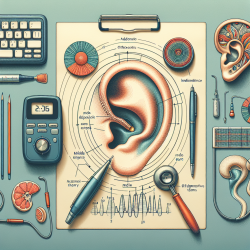Progress in understanding middle ear function has made significant strides, especially with the advent of acoustic impedance and admittance measurements. For practitioners in the field of audiology, integrating the findings from the research presented in "Acoustic Impedance and Admittance - The Measurement of Middle Ear Function" can be instrumental in enhancing diagnostic and therapeutic practices. This blog post will highlight key takeaways from the research and suggest ways to apply these insights in clinical settings.
Understanding Acoustic Impedance and Admittance
Acoustic impedance and admittance measurements are critical in evaluating middle ear function. These measurements help in diagnosing various conditions that affect hearing, such as otitis media, Eustachian tube dysfunction, and other middle ear pathologies.
Key Takeaways from the Research
- Historical Development: The study of middle ear function has evolved significantly, with notable advancements in measurement techniques over the past decade. Understanding the historical context can provide a deeper appreciation of current practices.
- Anatomy and Physiology: Comprehensive knowledge of the middle ear's anatomy and physiology is crucial. This includes insights into the tympanic membrane, ossicles, and Eustachian tube, which are essential for accurate diagnosis and treatment.
- Tympanometry: Feldman's chapter on tympanometry is particularly valuable. It covers procedures, interpretations, and variables in detail, making it an excellent resource for both novice and experienced audiologists.
- Pathologies: Terkildsen's review of pathologies and their impact on middle ear function provides a broad overview of conditions ranging from malleus fixation to brain-stem involvement. This chapter underscores the importance of extensive referencing in understanding these conditions.
- Clinical Applications: The research highlights practical methods for evaluating Eustachian tube function, testing tubal patency, and assessing ventilation function. These insights are directly applicable in clinical settings.
Implementing Research Outcomes in Practice
Integrating the findings from this research into clinical practice can lead to improved diagnostic accuracy and better patient outcomes. Here are some actionable steps:
- Stay Updated: Regularly review the latest research and advancements in acoustic impedance and admittance measurements. Attending conferences, webinars, and reading relevant publications can help you stay informed.
- Invest in Training: Ensure that you and your team are well-trained in the latest tympanometry procedures and interpretations. Consider investing in advanced training programs or workshops.
- Utilize Advanced Techniques: Apply advanced techniques and tools as highlighted in the research, such as multi-frequency tympanometry, to enhance diagnostic capabilities.
- Collaborate with Experts: Networking with other professionals in the field can provide valuable insights and foster collaborative efforts in research and clinical practice.
Encouraging Further Research
While the current research provides a solid foundation, there is always room for further exploration. Encouraging ongoing research in acoustic impedance and admittance can lead to new discoveries and innovations in the field. Consider the following:
- Participate in Studies: Engage in or support research studies that focus on middle ear function. Your participation can contribute to the advancement of knowledge in this area.
- Share Findings: Publish your own clinical findings and experiences in reputable journals. Sharing your insights can benefit the broader audiology community.
- Mentor Future Researchers: Encourage and mentor students or junior practitioners to pursue research in this field. Their fresh perspectives can lead to innovative approaches and solutions.
To read the original research paper, please follow this link:
Acoustic Impedance and Admittance - The Measurement of Middle Ear Function.










